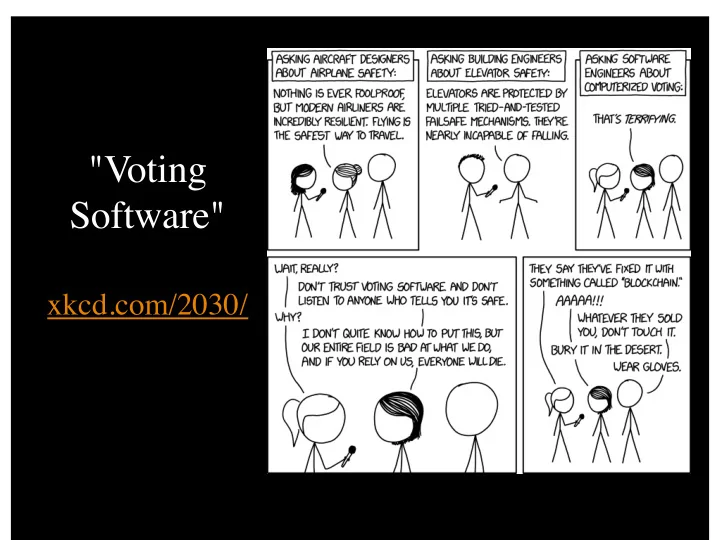

"Voting Software" xkcd.com/2030/
Cryptocurrencies & Security on the Blockchain The Blockchain Prof. Tom Austin San José State University
Lab Review
Byzantine General's Problem (Lamport et al. 1982) • Generals decide whether to attack a city. • If all (or most) attack, victory is sure. • If insufficient forces attack they will be crushed.
Complications • Some of the generals are traitors. – Fake messages. – Lie about messages received. • Messengers may be killed. • Should you confirm messages? • Should you confirm the confirmations? • Should you confirm the confirmations of the confirmations?
Traitorous Lieutenant (from Lamport et al. 1982)
Traitorous General (from Lamport et al. 1982)
Previous Solutions for Byzantine Fault Tolerance • Paxos – Provides distributed consensus – Formal safety guarantees – Complex • Raft – Simplified version of Paxos – Also makes formal safety guarantees – Still complex
James Mickens' The Saddest Moment "Whenever I go to a conference and I discover that there will be a presentation about Byzantine fault tolerance, I always feel an immediate, unshakable sense of sadness …"
Distributed Consensus • Anyone could lie to us. • With crypto- currencies, everyone is motivated to lie.
So what can we trust? Greed
Nakamoto Consensus • Probabilistically offers Byzantine fault tolerance. • Solving PoW puzzle determines "leader". – In other words, who gets to make a block. • Incentive structure. – More profitable to mine than double-spend.
What is a blockchain • Data • Cryptographic hash linking blocks • Sybil resistance
Block Information • Version • Timestamp • Previous block hash • Proof-of-work (PoW) target • Nonce (the "proof") • Merkle root
Block Information • Version • Timestamp • Previous block hash • Proof-of-work (PoW) target • Nonce (the "proof") The data • Merkle root
Block Information • Version The link • Timestamp • Previous block hash • Proof-of-work (PoW) target • Nonce (the "proof") • Merkle root
Block Information • Version • Timestamp • Previous block hash • Proof-of-work (PoW) target • Nonce (the "proof") • Merkle root The Sybil resistance
What data structure is a blockchain? • A tree – With mostly dead branches • Orphan blocks – The surviving branches have names: • Bitcoin Cash, Bitcoin Gold, etc. • A chain of "finalized" blocks • A tree of remaining possibilities
Blockchain Properties • Distributed • Decentralized • Immutable history • Time-stamping
Blockchain Limitations • Establishes agreed-upon ordering not necessarily the original ordering. • Nasty stuff stored on the blockchain. • Assumes actors are – Rational – Incentivized by profit
Irrational Actors
Nation-states
Lab: Blockchain Logger Details in Canvas and on course website.
Recommend
More recommend